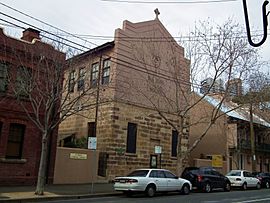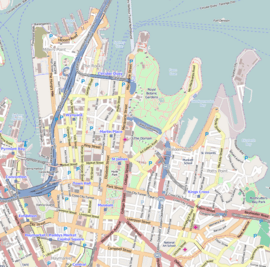St Brigid's Roman Catholic Church facts for kids
Quick facts for kids St Brigid's Roman Catholic Church |
|
|---|---|

St Brigid's Roman Catholic Church, and former school in 2012
|
|
| 33°51′31″S 151°12′14″E / 33.8587°S 151.2038°E | |
| Location | 14, 16 Kent Street, Millers Point, Sydney, New South Wales |
| Country | Australia |
| Denomination | Catholic |
| History | |
| Status | Active |
| Founder(s) | Bishop Dr William Bernard Ullathorne OSB |
| Architecture | |
| Functional status | Church |
| Architect(s) | Ambrose Hallen |
| Years built | 1834–1835 |
| Administration | |
| Parish | St Patrick's Roman Catholic Church, Sydney |
| Archdiocese | Sydney |
St Brigid's Roman Catholic Church is a very old and important church building in Millers Point, a suburb of Sydney, New South Wales, Australia. It's located on Kent Street. This church is special because it's one of the oldest places where Catholic people have worshipped in Australia. It was also once a school! The building is so important that it's listed on the New South Wales State Heritage Register, which means it's protected because of its history.
Contents
A Look Back: The Story of St Brigid's
The Catholic Church wasn't officially recognized in Australia until 1820. That's when Fathers Connolly and Therry arrived. Before that, some unofficial churches and schools likely existed. St Brigid's shows how early schools in New South Wales were often run by churches or private groups. Government-run schools didn't start until the 1840s. St Brigid's is thought to be the oldest church-run school still standing in New South Wales.
Building the First Church and School
The first design for St Brigid's, originally called St Bridget's, is credited to Bishop Dr William Bernard Ullathorne. He was a very important Catholic leader in Australia. The building was planned as a single-storey sandstone structure. It would have one classroom and a separate chapel.
Construction began in 1834, using stone found nearby. The building was finished in April 1835. It was ready for use in May 1835. Inside, folding doors divided the space into two classrooms, one for boys and one for girls. On Sundays, this school building also served as a chapel for Mass.
How the School Changed Over Time
At first, the Christian Brothers taught the students. By the 1870s, the Sisters of Mercy took over the school. In the early 1930s, Father Daniel Hurley, the local priest, got permission to add another storey to the building.
The original sandstone classroom and chapel became the church and apse you see today. The expanded school opened on August 31, 1933. When the upper storey was added in 1933, the spelling of the name changed to St Brigid's. This new construction allowed the ground floor to be used only as a church.
The school closed in 1992 because fewer students were attending. From 2002 to 2003, restoration work was done. This work helped to maintain and preserve the historic chapel, both inside and out.
The Architect: Ambrose Hallen
The building is one of the few remaining works by Ambrose Hallen. He was the Colonial Architect at the time. His work on St Brigid's is considered very important.
What St Brigid's Looks Like
The church is located on the western side of Observatory Hill. This hill is a sandstone cliff that separates Sydney Cove from Darling Harbour. The building shows its age and history through its design and materials.
Why St Brigid's is Important
St Brigid's Church and School is very important to the history of New South Wales. It has a special "State significance" for several reasons:
- It is the oldest building in Australia that has been continuously used for Catholic religious services. The ground floor, made of sandstone, has been a church since 1835.
- The site is strongly connected to Bishop Ullathorne. He was the first senior Catholic churchman in Australia. He helped set up the Catholic Church formally in New South Wales.
- The building is one of the few remaining works by the Colonial Architect, Ambrose Hallen.
- The building adds to the historical look of the local area. This area is recognized as being important to Australia's history.
St Brigid's Church and School helps us understand the religious and educational life of the community over a very long time. It holds special meaning for the history of the Catholic community in Australia. It was officially listed on the New South Wales State Heritage Register on April 2, 1999.
See also
- Roman Catholicism in Australia


